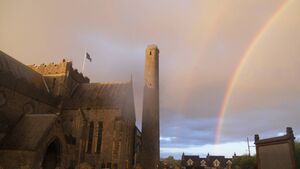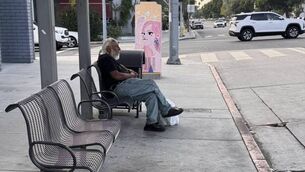Resistance to synodal church is now evident

A rainbow forms a perfect backdrop at St Canice's Cathedral in Kilkenny. Picture: Rosaleen Crotty
Delegates from the Catholic dioceses of Ireland gathered in Kilkenny Convention Centre on October 18th to help prepare for a National Synod to be held in October, 2026 which is intended to usher in a ‘synodal’ church in Ireland. The Kilkenny meeting was a follow-up to a similar meeting in Athlone three years earlier when reports from the dioceses of Ireland were summarised by a national synodal committee.
The Athlone meeting was a great success in that unexpectedly the shape of a future Church became clear as the issues raised in the individual diocesan reports revealed an extraordinary if unexpected similarity. To such a degree indeed that the outline of the map forward was obvious and was summarised in a number of key priority issues that the Catholics of Ireland had clearly indicated needed to be addressed. So far so good. Unsurprisingly, the delegates representing all the Irish dioceses left Athlone on a wave of gratitude and optimism.
One of the outstanding issues noted in Athlone was the role of women in the Church. Every diocese had listed the women’s issue in the first three priorities. The National Synodal Committee had fine-tuned the listed issues into seven in preparation for the Kilkenny meeting, which was itself designed to continue mapping out the ground for ‘what God wants for the Irish Church in the future’. And among the seven issues on the agenda for Kilkenny was the role of women.
The central formula of the Kilkenny event was ‘Conversation in the Spirit’, a synodal technique which enhances a sharing of ideas through a process of attentive listening.
It lasted almost two hours at the end of which the ideas that had emerged were listed and two people were asked to summarise the results. In the report back, one of the tellers (a woman) expressed surprise that out of the hundreds of ideas listed, only three mentioned the women’s issue.
To say that statistic was greeted with widespread astonishment would be an understatement. We looked at each other wondering how such a volte-face, a stunning reversal of the Athlone experience, could be explained. It was as if somehow we had lost our bearings and ended up in a cul-de-sac. Or even lost our way completely. Something was different, very different and we struggled to identify it.
My own view is that the make-up of the Kilkenny gathering was, as many suggested, quite different from that of Athlone. While the Athlone delegates were mainly people from and focussed on parish life, Kilkenny seemed to have drawn many delegates more anxious to further the particular agendas of the different associations they represented. This was very obvious and indeed was alluded to afterwards by Archbishop Martin of Armagh who saw the presence of new delegates as a positive - attracting a more widely based support for synodality. I didn’t.
In the group of seven I was in, one delegate who represented a marginal Catholic society kept insisting that his group should be established in every parish and effectively demanded that it be included in the list of priorities even though no one else in the group supported the idea. Another was a young man who represented an evangelical youth group and who demanded similar attention. A third was the individual who volunteered to take notes and then added his own personal enthusiasm to the list.
My conclusion from the group experience was two-fold (i) that ‘Conversation in the Spirit’ should not be attempted unless those participating have some understanding of the process and (ii) a facilitator to guide each group is absolutely essential. Instead of a focus on attentive listening, it became a debate in which a more argumentative tactic was employed of insisting on a personal view that sometimes extended almost to a form of bullying.
Another view shared by delegates whose opinion I valued was that too much time was devoted to the theological framework that sustains a synodal pathway and too little to a discussion of the seven issues presented by the committee and how they could be moved forward. There is a limit to what can be said about the centrality of Baptism – crucial though that context is. In respect for the Athlone experience, at least half of the Kilkenny meeting should have been devoted to moving forward the issues agreed at Athlone.
Another problem was that the lack of focus on the seven issues at the expense of a surfeit of theology was perceived as an undermining strategy to purposely talk synodality into the ground. The perceived lack of momentum and action in the three-year lacuna between Athlone and Kilkenny constituted (some believed) grounds for accusations even of institutional conspiracy!
At the same time, while progress is not always susceptible to haste, hope can begin to wither unless something is seen to be happening. The usual dance of the Church in taking two steps forward and one step back jars, particularly when it is set against a background of push-back to synodality evident among some priests and disinterest evident among some bishops.
There is a need not to feed a perception that particular groups are exerting undue influence in attempting to deliver their own agenda – no matter how laudable their programme or how necessary their age-syndrome. Four provincial mini-synods leading to a single National Synod might re-create a necessary focus on the issues in common rather than on groups or individuals. Another suggestion is that finding the right questions and tightening up control of repetitive contributions from the floor - ‘if it has been said, don’t repeat it’ - may be the key to keeping the focus on the primary task of the synod, ‘what God wants for the Irish Church in the future’.
The necessary focus now should be on recapturing the passion and the momentum of the Athlone event and progressing the kind of formation in synodality for people, priests and bishops that is as obvious as it is necessary.






